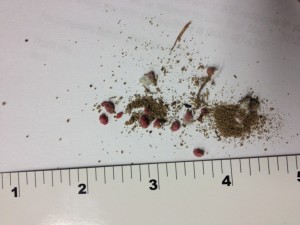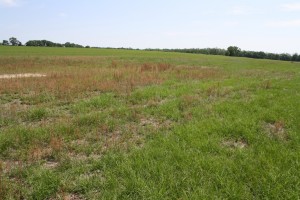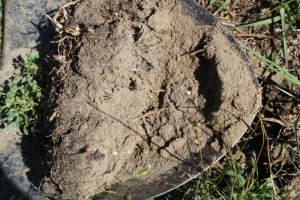I recently visited a farm that was experiencing significant stand loss in an 80 acre field of Tifton 9 Bahiagrass. Upon closer examination the culprit was determined to be ground pearls, as seen in the photo at left. This was the first time that this Extension Agent has ever verified ground pearls in a field situation to this degree. They were epidemic in this portion of the affected field. Typically, ground pearls are more commonly seen in turfgrass/lawn/landscape situations. Dry weather such as we have been experiencing seems to play a part in damage caused by ground pearls as well.
Ground pearls can be devestating, and they are difficult to control. In pasture situations we do not have any insecticides labeled that are effective in controlling this pest. Currently the only practical control method is rotation to agronomic crops with the hope of decreasing populations. Following are a few more pictures of the field and the ground pearls. 
This next photo shows active adult females and some of the females that have begun to develop the waxing coating for the egg production phase of the life cycle.
Some more information on Ground Pearls:
Order: Hemiptera
Family: Margarodidae
Scientific Name: Margarodes Spp.
Description
Adult. About 1.6 mm long, the adult female is a pinkish scale insect with well-developed forelegs and claws. The male is a gnat-like insect varying from 1 to 8 mm in length.
Clusters of pinkish-white eggs are enveloped in a white waxy sac.
Commonly referred to as a ground pearl, the slender nymph is covered with a hard, globular, yellowish-purple shell. An encysted nymph varies from 0.5 to 2.0 mm in diameter.
Biology
Ground pearls are potentially serious problems in both southeastern and southwestern states. The roots of Bermuda, St. Augustine, zoysia, and centipede grasses are most commonly infested with ground pearls. The ground pearl nymphs extract juices from underground plant parts. The damage is most apparent during dry spells when irregularly shaped patches of grass turn yellow. The grass in these spots eventually turns brown and usually dies by fall.
Overwintering takes place in the ground pearl stage. Females usually reach maturity in late spring and emerge from their cysts. After a brief period of mobility, the wingless females settle 5 to 7.5 cm. deep in the soil and secrete a waxy coat. Within this protective covering, females develop eggs (without mating) and deposit them through-out early summer. Approximately 100 eggs are laid by each female. The slender nymphs emerge in mid-summer and infest grass rootlets. Once they initiate feeding, nymphs soon develop the familiar globular appearance. There is usually one generation each year. However, if conditions are not favorable for emergence, female nymphs may remain in the ground pearl stage for several years.
Submitted by Shep Eubanks, Holmes County Extension Director
 0
0



